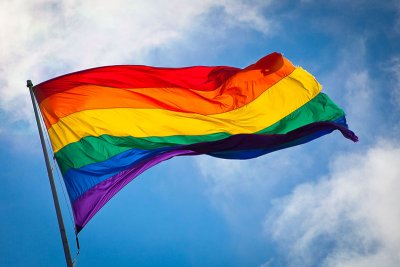
The rainbow flag flies over San Francisco’s Castro District. Photo: Benson Kua. Source: Wikimedia Commons.
On January 20, 2015, President Obama said the word transgender in his State of the Union address. It was only a word — but given that Ronald Reagan refused even to say the word AIDS publicly until 1985 because he was so disgusted by sexual diversity, the president’s choice to use that word counts for a very great deal. When I started my last book in the early aughts, people to whom I mentioned the trans kids I was writing about were astonished that they existed; some were appalled by what they took to be a precocious sexual perversion. But as one trans activist said to me, “Trans is who you are; sexuality is whom you bounce it off of,” and people can accept who someone is more readily than what someone does. Now federal prisoners’ gender transitions are covered by government funds, and in 2013, the DSM, the bible of psychiatry, shifted its code from gender-identity disorder, which posited that all trans people were mentally ill, to gender dysphoria, the supposition that it is not inherently diseased minds but sadness about their wrongful bodies that warrants intervention. It is now accepted that you are who you say you are.
Trans and gay are not the same thing experientially, but they have been amalgamated politically under the now-dominant LGBTQ banner — a necessity given the much larger number of gay people than trans people. But that very acronym speaks to diversity within this embracing queer community and acceptance of that diversity outside it. How did it happen? The night of Obama’s election in 2008 was a painful one for many gay people. I welcomed this new president, but I mourned Proposition 8 passing in California, revoking the right to marriage where it had already been granted; grieved over the state constitutional amendments in Florida and Arizona that made gay marriage illegal.
But the setback turned out to be galvanizing. A decade or so after the introduction of effective HIV treatment, LGBTQ people were empowered to talk about something other than AIDS, to fight for esteem instead of fighting merely for the right to remain alive. The coherence the movement for gay rights had achieved as it fought disease was now focused on seeking acceptance, and through a bewildering alchemy, the test case became marriage.
I used to be ashamed of being gay. For all that I put on a good show of pride, I used to feel I was making the most of an unfortunate situation. Partly, that changed because I grew up, achieved self-acceptance, met my husband, and had kids, all of which salved the regret. But also, the world stopped pitying me. The external validation of the class of human beings to which I belong has worked a subtle magic. Our assertions of pride have finally achieved that pride.
(To read the full feature, “Eight Years in America: Hope, and What Came After,”
please visit New York Magazine.)











